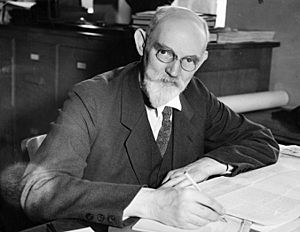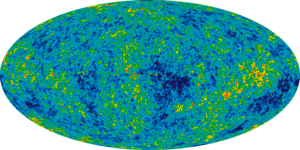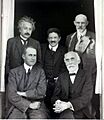Willem de Sitter facts for kids
Quick facts for kids
Willem de Sitter
|
|
|---|---|
 |
|
| Born | 6 May 1872 |
| Died | 20 November 1934 (aged 62) Leiden, South Holland, Netherlands
|
| Nationality | Dutch |
| Alma mater | Groningen University |
| Known for | de Sitter Universe |
| Scientific career | |
| Fields | Physics |
| Doctoral advisor | Jacobus Kapteyn |
| Doctoral students | Dirk Brouwer Willem Hendrik van den Bos |
| Signature | |
 |
|
| Physical cosmology | ||||||||||||||
 |
||||||||||||||
| Universe · Big Bang Age of the universe Timeline of the Big Bang Ultimate fate of the universe
|
||||||||||||||
Willem de Sitter (born May 6, 1872 – died November 20, 1934) was a famous Dutch mathematician, physicist, and astronomer. He is best known for his ideas about how the universe works and expands.
Contents
Life and Discoveries
Willem de Sitter was born in Sneek, a town in the Netherlands. He loved numbers and the stars from a young age. He went to the University of Groningen to study mathematics. After finishing his studies, he joined the astronomy lab there.
He worked at an observatory in South Africa for a few years. An observatory is a place with powerful telescopes to study space. In 1908, he became a professor of astronomy at Leiden University in the Netherlands. Later, he became the director of the Leiden Observatory in 1919 and stayed there until he passed away.
Understanding the Universe
De Sitter made big contributions to how we understand the universe. He worked with Albert Einstein, another very famous scientist. In 1932, they wrote a paper together. They talked about what new information about the universe meant for its shape and how it curves.
De Sitter also came up with the idea of the de Sitter space and the de Sitter universe. These were solutions to Einstein's theory of general relativity. In his model, the universe has no matter, but it expands very quickly. It's like an empty universe that keeps getting bigger and bigger.
He also spent a lot of time studying the movements of the moons around the planet Jupiter. This helped scientists understand how planets and moons move in space.
Willem de Sitter died in November 1934 after a short illness.
Honors and Awards
Willem de Sitter received many awards for his important work.
- In 1912, he became a member of the Royal Netherlands Academy of Arts and Sciences. This is a special group for top scientists and artists.
Major Awards
- James Craig Watson Medal (1929)
- Bruce Medal (1931)
- Gold Medal of the Royal Astronomical Society (1931)
- Prix Jules Janssen (1934) – This is the highest award from the French astronomical society.
Things Named After Him
Many things in science and space are named after Willem de Sitter because of his important discoveries.
- The crater De Sitter on the Moon
- Asteroid 1686 De Sitter
- de Sitter universe – A model of an expanding universe
- de Sitter space – A mathematical idea related to his universe model
- Anti-de Sitter space
- Einstein–de Sitter universe – Another model of the universe he helped create
- de Sitter precession – A way that orbits can slowly change
His Family
Willem de Sitter had children who also became successful.
- His son, Ulbo de Sitter (1902–1980), was a Dutch geologist. Geologists study the Earth's rocks and history.
- One of Ulbo's sons, also named Ulbo de Sitter (1930–2010), became a Dutch sociologist. Sociologists study human society.
Another son of Willem, Aernout de Sitter (1905–1944), was the director of the Bosscha Observatory in Indonesia. He studied a group of stars called the Messier 4 globular cluster.
Images for kids
See also
 In Spanish: Willem de Sitter para niños
In Spanish: Willem de Sitter para niños
- de Sitter double star experiment
- de Sitter precession
- de Sitter space
- de Sitter universe
- Anti-de Sitter space


